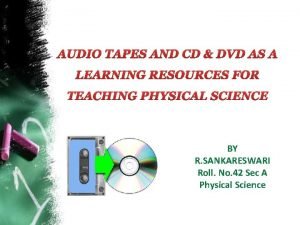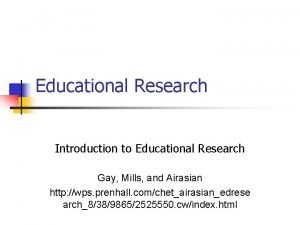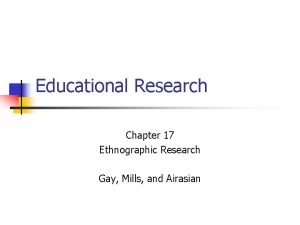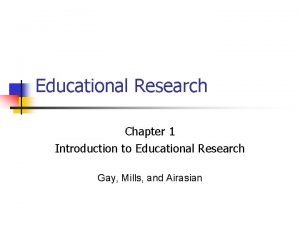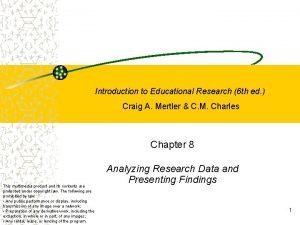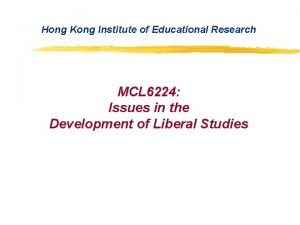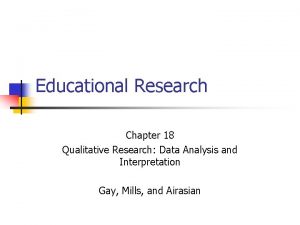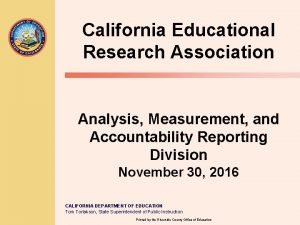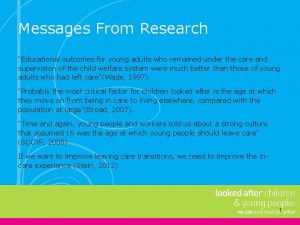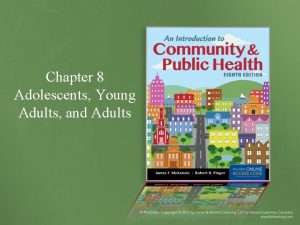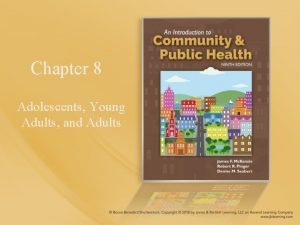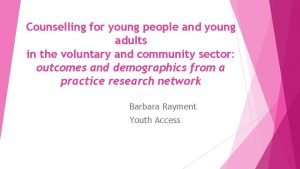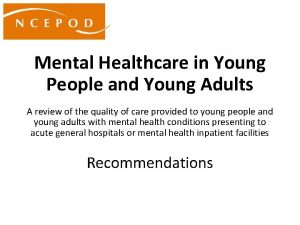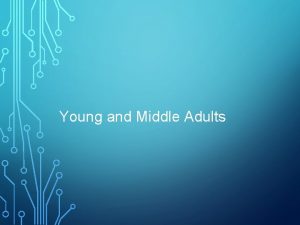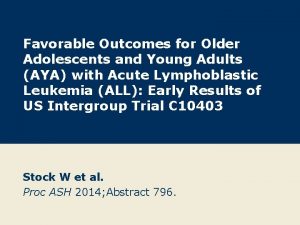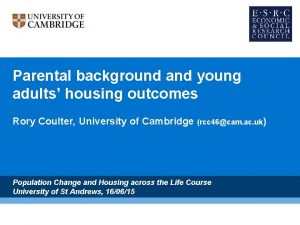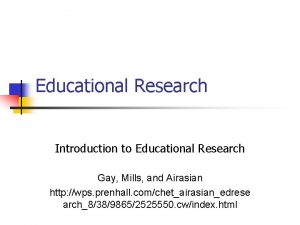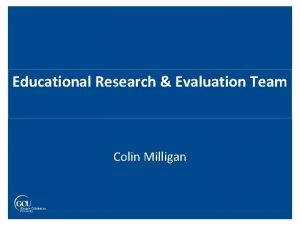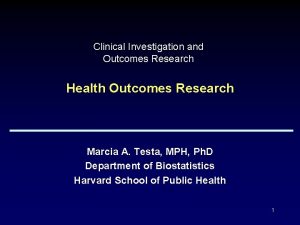Messages From Research Educational outcomes for young adults









































- Slides: 41

Messages From Research “Educational outcomes for young adults who remained under the care and supervision of the child welfare system were much better than those of young adults who had left care”(Wade, 1997). “Probably the most critical factor for children looked after is the age at which they move on from being in care to living elsewhere, compared with the population at large”(Broad, 2007). “Time and again, young people and workers told us about a strong culture that assumed 16 was the age at which young people should leave care” (SCCYP, 2008). If we want to improve leaving care transitions, we need to improve the incare experience (Stein, 2012) 1

Moving Out & Moving On. . Discuss the age at which you left home…. Why was that… Where did you go… Was this planned or unplanned… What sort of preparations did you make… What sort of support did/do you have… What sort of emotions did this invoke… Do you (did you) think you were ready…

Leaving home & leaving care in Scotland 25+ Average for leaving home in Scotland 17 Average for leaving care There has been a 20% increase in 20 -34 year olds living with parents since 1997. 29% Young Men Scottish Government Statistics 18% Young Women

Sweet 16…? The average of leaving care…. Time and again, young people and workers told us about a strong culture that assumed 16 was the age at which young people should leave care. Sweet 16? The Age of Leaving Care in Scotland SCCYP 2008

One Care Journey Pre-Care Experience § Pre-birth § Neural Development § Parenting Capacity/Care Experience § Developmental Milestones § Trauma, Neglect & Abuse § Pre Care experiences § Transition Into Care § Attachment & Resilience Continuing relationships Looked After Experience § Age at entry into care setting § Family & sibling contact § Identity § Multiple Placements & Transitions § Stability & Consistency § Felt Security § Educational Experience § Connection & Belonging Transitions & Aftercare § Age at moving out/moving on § Person-Centred Planning § Staying Put & Continuing care § Extended & Graduated Transitions § Relationship-Based Practice § Connection & Belonging § Aspirations & Expectations § Post care Support into adulthood

Young people’s comments “They’re saying to me ‘sooner or later someone’s going to need that bed’. They make you worry and feel guilty. ” “I was saying I wasn’t ready but felt I had to go. ” “I know a lot who’ve left at 16/17. A few are working or are at college. Others just sit there. Nothing to do, no money…If you start working you pay your own B&B. ” Sweet 16? The Age of Leaving Care in Scotland SCCYPP 2008

Sweet 16 recommendation 3 Firm steps must be taken to change the culture that expects young people to leave care at 16. Local authority policy and practice should emphasise that proper care until 18, and appropriate support thereafter, is a right and not an option Sweet 16? The Age of Leaving Care in Scotland SCCYPP 2008

Underlying implications The underlying implication of social policy is that young people do not reach full adulthood until the age of 25. Until that point benefit and grant rules make it clear that there is an expectation that they can remain financially dependent upon their parents.

Staying Put Scotland 2013: An Explicit Philosophy of Care Staying Put: looked after young people are encouraged, enabled and empowered to remain in positive care settings until they are ready to move on towards more independent living. Graduated & Extended Transitions: ensure the avoidance of accelerated, abrupt transitions from care settings for looked after young people and care leavers Post Care Accommodation Options: Housing Options Protocols for Care Leavers - Guidance for Corporate Parents and Community Planning Partnerships: Staying Put Scotland Providing care leavers with connectedness and belonging Guidance for Local Authorities and other Corporate Parents http: //www. scotland. gov. uk/Resource/00435935. pdf 9

Children (Scotland) Act 1995 Duties & Powers S 29 of the Children (Scotland) Act 1995 sets out local authority responsibilities to young people who leave care after they are over school leaving age. Under S 29 (1) there is a duty – unless the local authority is satisfied that the young person’s welfare does not require it – to advise, guide and assist those under 19. Under S 29(2) there is a power to provide advice, guidance and assistance to young people between 19 and 21 who apply to the local authority, unless the authority is satisfied that the young person’s welfare does not require it. Local authority assistance may be in cash or in kind. Under S 30 the local authority is empowered to give financial assistance towards the expenses of education or training of care leavers under the age of 21 years; also under S 30(1), assistance may be granted to meet expenses in respect of accommodation and maintenance in any place near his/her employment.

The Children and Young People (Scotland) Act 2014 Corporate Parenting (Part 9): identifies additional range of Corporate Parents and imposes new duties upon them Aftercare (Part 10): extends the entitlement to receive advice, guidance and assistance from the local authority up to their 26 th birthday (subject to assessment of eligible needs) Continuing Care (Part 11): Duty on local authorities to support young people, 16+ who cease to be looked after, to remain in the same accommodation and receive other assistance, up to their 21 st birthday http: //www. legislation. gov. uk/asp/2014/8/contents/enacted 11

What is ‘corporate parenting’? An organisation's performance of actions necessary to uphold the rights and safeguard the wellbeing of a looked after child or care leaver, and through which physical, emotional, spiritual, social and educational development is promoted http: //www. gov. scot/Resource/00483676. pdf

Continuing Care (Part 11) Continuing Care’ is a legal term introduced by the 2014 Act. Duty on local authorities to provide care leavers whose final placement was ‘away from home’ with a continuation of the kinds of support they received prior to their ceasing to be looked after (including accommodation in a ‘looked after’ placement). Young person will have to cease to be looked after to be eligible for ‘Continuing Care’, but the day-to-day experience is same Exceptions § Young person leaves accommodation of their own volition § Accommodation ceases to be available § Placement would significantly adversely affect the welfare of the young person Children & Young People (Scotland) Act 2014

Continuing Care (Part 11) § The 2014 Act changes the legal definition of a ‘care leaver’. § From April 2015 any young person who ceases to be looked after on or after their 16 th birthday will be classified as a ‘care leaver’. § All looked after children can become ‘care leavers’, including young people who were classified as ‘looked after at home’ and in formal kinship care. § The 2014 Act extends eligibility to ‘Aftercare’ services to care leavers up to their 26 th birthday Children & Young People (Scotland) Act 2014

Aftercare (Part 10) ‘Aftercare’ is defined as ‘advice, guidance and assistance’. This can include (but is not restricted to) helping a young person to secure accommodation, education and employment opportunities, and financial support. Any young person who ceases to be looked after by a local authority on or after their 16 th birthday will be eligible to ‘Aftercare’ services. Care leavers aged between 19 and 21 who are currently in receipt of ‘Aftercare’ will be able to continue to receive support up to their 26 th birthday Care leavers aged 19 – 26 will be entitled to request assistance from their local authority. The local authority has a duty to undertake an assessment and, if the care leaver is assessed as having eligible needs which cannot be met by other means, the local authority must ensure these are met Children & Young People (Scotland) Act 2014

Definitions Through care is the on-going preparation and support for young people who have been looked after and who may soon be making the transition to live more independently. Aftercare is the continuing support, planning and guidance for a young person who has left care or a supported living environment. Pathways Handbook Scottish Government 2004

Core message A core message from research suggests that while leaving care represents a crucial moment in a young person’s life, it needs to be built upon the firm foundation of a stable and positive experience of being looked after during which young people can be adequately prepared for adult life. Helping care leavers: Problems and strategic responses Stein, M and Wade, J 2000

TCAC Assessment… Duty to assess & plan Timing of assessment The authority has a duty to perform a needs assessment on all currently looked after, compulsory and prospective supported persons. It also has a duty to provide a pathway plan and appoint a life coach for all compulsory and discretionary supported persons, and may provide a pathway plan and a life coach for currently looked after persons Only in exceptional circumstances should a young person not have their needs assessment and pathway plan completed before they leave care and a plan in place as to their future. Regulations and Guidance on Services for Young People Ceasing to be Looked After by Local Authorities Scottish Government 2004

Pathways Planning The focus of Pathways needs to be on gathering views, identifying need, planning action and reviewing progress. It is not a form-filling exercise or a one-off event. The materials provide the framework § make it a meaningful process § take a flexible approach § keep the young person at the centre Pathways Handbook Scottish Government 2004 http: //www. gov. scot/Publications/2004/05/19357/ 37097

Pathways key messages § Keep the young person at the centre § Make it a meaningful process § Take a flexible approach § Consider how SHANARRI wellbeing indicators apply to young people leaving care Pathways Handbook Scottish Government 2004

Person-centred planning § There is increasing use in practice of the PCP approach to Pathways planning. § This approach can better enable the young person to be genuinely at the centre of their leaving care Pathway plan § It acknowledges the leaving care assessment and plan as a “dynamic” process; and requires a genuine partnership between agencies and care leavers. Person-Centred Planning In Social Care: JRF Publications Personalisation Through Person–Centred Planning: Do. H “A plan of care does not replace the need for a child to have a vision for their life“ (Kiaras Gharabaghi)

The importance of stability at times of transition Children and young people do not always leave care post 16. Many experience transitions back from temporary care settings at a younger age. It is important for these children to experience as little disruption in other key areas of their lives at these times. Maintaining consistent school placements, key relationships, access to hobbies, clubs and friends is crucial in maintaining a sense of control and normality to counter the emotional vulnerability many can experience.

Journeys to Adulthood Making the journey to adulthood and independence is a life changing process, not a bureaucratic event and it is crucial that care leavers are not further disadvantaged by having to make abrupt, life changing decisions and transitions at an earlier stage than their peers. We know that young people who stay for longer in positive care placements, benefitting from the stability and security that this offers, and leaving later, enjoy better outcomes in terms of education, employment and health. As Corporate Parents it is our role to ensure that looked after young people and care leavers are given the very best life chances and opportunities as we would our own children through continuous on-going support

A Sense of Belonging… School connectedness is, after family, the next most powerful protective factor in young peoples lives Regardless of academic ability or attainment, it is the sense of “belonging” that helps develop emotional resilience. Relationships count: Behind most successful young people there is someone who ‘goes the extra mile’ and has ‘made the difference’ – often ‘in spite of’ the system. Young people need to be allowed to form attachments and develop good relationships to succeed. Blum R & Rinehart P Reducing The Risk: Connections That Make A Difference In The Lives Of Youth (University of Minnesota 1997) Mike Stein Resilience & Young People Leaving Care: JRF 2010

Scottish Care Leavers Covenant (2015) A Promise to Actively endorse the Scottish Care Leavers Covenant and commit to uphold and promote its principles, within and across their remits and responsibilities and; Take specific relevant action to fully support and implement the Agenda for Change in order to close the gap and make real our ambitions and aspirations for care leavers

Guiding Principles Care-proofing of policy: Corporate parents recognise the vulnerability of care leavers as young adults, with explicit reference to, and prioritisation of them as a ‘protected group’ in policy documents. Assumption of entitlement: A default position where care leavers are entitled to services, support and opportunities, up to their 26 th birthday. Where discretion exists in definitions of vulnerability or in giving priority access, these are exercised in favour of care leavers. Staying Put and Continuing Care: The full and meaningful implementation of Continuing Care where looked after young people and care leavers are actively encouraged, enabled and empowered to ‘stay put’ in positive care settings until they are ready to move on. Relationship-based practice: All good practice is based on good relationships, based on understanding, empathy, respect, and ‘stickability’. Young people are supported to maintain positive relationships and attachments with previous carers and professionals throughout their care experience and beyond. http: //www. scottishcareleaverscovenant. org/

http: //www. scottishcareleaverscovenant. org/ 27

Guidance for local authorities on leaving care Social work departments and education departments should work together to ensure that young people who are looked after achieve their maximum potential within the education system. Young people moving to adulthood are often hampered by lack of formal academic qualifications. Good links between social workers and designated teachers will allow young people's progress to be monitored and encouraged. Continuing education, training and employment can help young people establish themselves as successful and independent adults. Local authorities should work closely with Careers Scotland who can assist young people in making choices for education and training. Regulations and Guidance on Services for Young People Ceasing to be Looked After by Local Authorities Scottish Government 2004

Promoting a culture change We need to raise the age at which young people leave care by challenging unrealistic expectations and encouraging, supporting and enabling young people to remain in positive care placements until they are able and ready to move on. We need to extend the transitional timescale for moving on – avoid cliff edge transitions/point-of-no-return scenarios. Most of us leave home on a graduated basis over several years. Care leavers should have the same opportunities of “returning “home” to care settings” when things don’t work out first time around If this was your child or young person, what would you do?

Creating a Corporate Parenting Culture Local authorities and key agencies provide young people who have been looked after with ongoing support into adulthood, as any other responsible parent would for their children. All local authority departments recognise that they have responsibilities to ensure the welfare of looked after and formerly looked after children and young people. All agencies work together to play their part in meeting the wide range of young peoples needs Local authorities have a corporate parenting group or committee and a named senior person in each department to be accountable for ensuring that corporate parenting responsibilities are fulfilled Every local authority has a statement of intent on how they will fulfil their corporate parenting responsibilities for all looked after and formerly looked after children and young people. Striving to ensure that looked after young people can achieve the best possible positive outcomes in life. “How Good Is Your Throughcare & Aftercare Service Scottish Throughcare & Aftercare Forum

Age of children ceasing to be looked after 2010 1600 1400 1200 1000 Under 5 5 -11 800 1408 1303 600 16+ 1032 1003 400 200 0 Under 5 5 -11 12 -15 16+ Scottish Government – Children’s SW Statistics 2012 6% of children ceasing to be looked after had been looked after for under six weeks. A further 14% had been looked after for five years or more. Around 29% had been looked after for less than a year.

Young people eligible for aftercare services Accommodation Age Total % 15 -16 17 18 19 -21 111 141 132 110 494 13 * * 0 * 2 0 Friends / relatives 25 82 68 66 241 7 Own tenancy / independent living 34 133 193 366 726 20 Supported accommodation / semi-independent living 38 83 80 93 294 8 * * 15 24 46 1 In residential care 11 * 15 * 34 1 Homeless 11 27 35 32 105 3 In custody 11 27 35 32 105 3 Other destination 17 21 23 33 94 3 Not known 53 80 109 221 463 13 Not receiving aftercare 200 326 327 250 1103 30 Total 504 916 1017 1225 3662 100 Home with (biological) parents Home with newly-adoptive parents Former foster carers Scottish Government – Children’s SW Statistics 2012 Young people eligible for aftercare services on 31 st July 2011, by age and type of accommodation

Transient situations Young people who have been in care may return to the family home but this can be a transient situation and often disrupts leaving care arrangements, particularly accommodation provision. Young people who find it difficult to keep to the rules of accommodation provision can be excluded from having access to the services they need although they might be among the most vulnerable of those leaving care Review of Research on Vulnerable Young People and Their Transitions to Independent Living TSE 2007

Economic activity of young people eligible for aftercare services 2010/11 64% of all care leavers whose economic activity status was known were not involved in education, training or work. Young care leavers who have a disability may find it more difficult to make a transition to adult life. They have often missed large amounts of education and there is very little specialised support to enable them to take up employment. Many young people with severe disabilities stay in education until they are 19, and then go on to day care centres or FE colleges that have relevant courses. Those with mild or moderate disabilities can find themselves repeating the same training course several times because this has been made a condition of their receiving welfare benefits Scottish Government – Children’s SW Statistics 2012

Continuing impact of trauma I would love to go and get a job, but it’s like my maths is atrocious … I get really panicky if I feel that I can’t do something. . . I’d love to go to college, but I’m scared of being bullied again. Go through all the trauma and everything just … how can I say? Just the thought of going, it scares me, scares the life out of me. The experiences of young care leavers from different ethnic groups JRT 2005

Everything comes at once Having all the worries of, what am I going to do? Am I going to life independently? Semi-independence? Where am I going to live? … all the worry of what decision I’m going to make career-wise, and then all the worries of my exams … Also there are other problems with puberty; your body’s changing a lot as well at that time …” What Makes The Difference Project 2007

Family Firm Opportunities Good parents help their children with opening doors to employment opportunities, directly or indirectly - often in the “family firm”. There a growing number of examples of how local authorities can help redress the disproportionate disadvantage faced by looked after young people and care leavers when faced with access to an increasingly competitive and limited youth jobs market Often as the areas largest employers, local authorities are uniquely placed to offer dedicated employment opportunities to their looked after young people – either directly or through tendering and outsourcing protocols. If this was your child or young person, what would you do to help them secure employment? Our Family Firm: A Working Framework for Community Planning Partners and Employers Scottish Govt: 2011

Supporting Higher & Further Education Young people with a care background may have experienced some disruption in their education. We know that educational outcomes can poorer. However we also know that looked after young people and care leavers can go on to successfully achieve through higher and further education. Developing positive relationships with local colleges and universities and developing information sharing protocols and support structures can greatly assist care leavers to overcome some of the obstacles they may face in moving onto and sustaining higher & further education. The Buttle UK Quality Mark for Care Leavers is awarded to further and higher education providers who demonstrate their commitment to young people in and leaving care. The Buttle UK Quality Mark Model: Working with your institution to support Care Leavers in HE Buttle UK / University of Bradford 2012

Post Care Accommodation When young people do eventually move on it is essential that they move into appropriate accommodation which is: § Safe § Secure § Stable § Supported § Somewhere you be happy to see your own child settled… http: //www. gov. scot/Resource/00435939. pdf https: //www. celcis. org/files/7114/3938/6983/Inform. Housing_Options_and_Care_Leavers. pdf

What is associated with good outcomes for care leavers? § Stable careers § Life skills preparation § Continuous schooling § Leaving care older than age 16 § Foster care background § § Encouragement of carers to do well Good social networks, relationships and self esteem § Carer seeing promoting education as one of their central tasks Stability in accommodation after leaving care § Support from leaving care team § § Birth parent valuing education § High realistic aspirations

Aspirations I would have liked, in the personal development plans, I would have liked them to lay out ‘Where do you want to go in the future? . . . What are your aspirations? Where would you like to go? How can we help you develop as a person? ’ Because if you’re developed as a person then you can live on your own more successfully generally. I would have liked them to ask me … courses or places to look for courses. But I didn’t get none of that. The experiences of young care leavers from different ethnic groups JRT 2005
 Disadvantages of tape recorder in teaching and learning
Disadvantages of tape recorder in teaching and learning Money smart fdic
Money smart fdic Fire escape plan
Fire escape plan Thesis title about crops
Thesis title about crops Expected outcomes in research examples
Expected outcomes in research examples Qualitative approach
Qualitative approach Preference for specific design control for procedural bias
Preference for specific design control for procedural bias State council of educational research and training
State council of educational research and training Educational research gay
Educational research gay Ethnographic research
Ethnographic research Educational research and development
Educational research and development Introduction to educational research mertler
Introduction to educational research mertler Categories of educational research
Categories of educational research Hong kong institute of educational research
Hong kong institute of educational research Interpretation of data example
Interpretation of data example California educational research association
California educational research association Fspos
Fspos Typiska novell drag
Typiska novell drag Nationell inriktning för artificiell intelligens
Nationell inriktning för artificiell intelligens Ekologiskt fotavtryck
Ekologiskt fotavtryck Varför kallas perioden 1918-1939 för mellankrigstiden?
Varför kallas perioden 1918-1939 för mellankrigstiden? En lathund för arbete med kontinuitetshantering
En lathund för arbete med kontinuitetshantering Adressändring ideell förening
Adressändring ideell förening Tidbok yrkesförare
Tidbok yrkesförare Anatomi organ reproduksi
Anatomi organ reproduksi Densitet vatten
Densitet vatten Datorkunskap för nybörjare
Datorkunskap för nybörjare Stig kerman
Stig kerman Tes debattartikel
Tes debattartikel Magnetsjukhus
Magnetsjukhus Nyckelkompetenser för livslångt lärande
Nyckelkompetenser för livslångt lärande Påbyggnader för flakfordon
Påbyggnader för flakfordon Tryck formel
Tryck formel Svenskt ramverk för digital samverkan
Svenskt ramverk för digital samverkan Kyssande vind analys
Kyssande vind analys Presentera för publik crossboss
Presentera för publik crossboss Vad är ett minoritetsspråk
Vad är ett minoritetsspråk Vem räknas som jude
Vem räknas som jude Treserva lathund
Treserva lathund Epiteltyper
Epiteltyper Claes martinsson
Claes martinsson Centrum för kunskap och säkerhet
Centrum för kunskap och säkerhet
